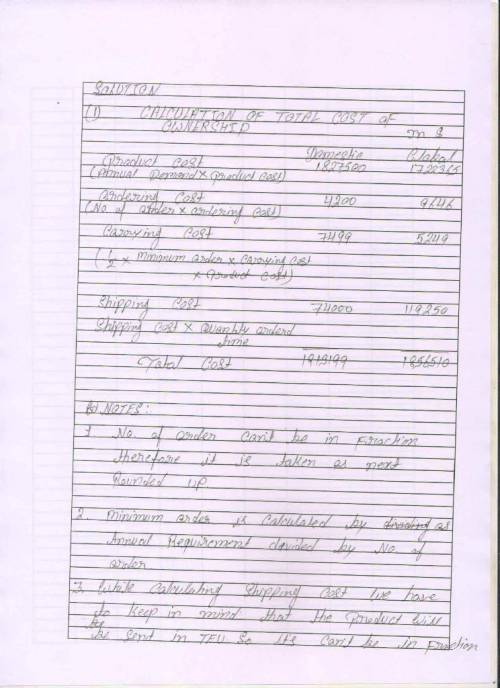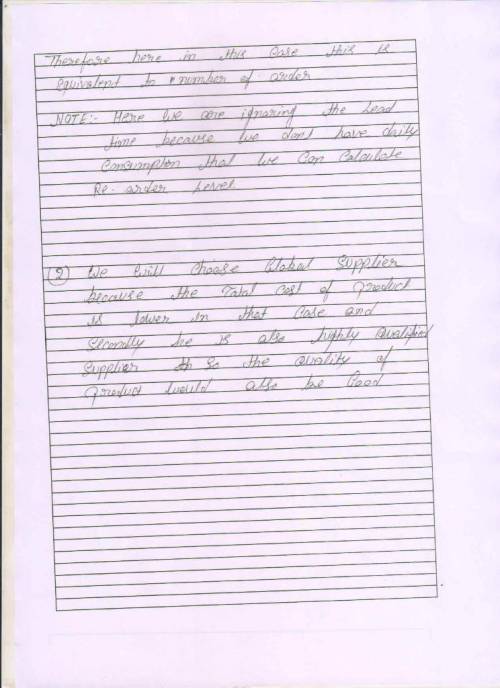Tco case study distribution example 2015 version 1.2 you work for idc distributions llc.
...

Business, 22.11.2019 06:31 gjvyverman
Tco case study distribution example 2015 version 1.2 you work for idc distributions llc.
you're responsible for sourcing new products. your company is launching a new product. you’ve found two possible sources – a domestic manufacturer and a manufacturer based on south korea. below are more details about each of the manufacturers.
domestic manufacturer
the domestic manufacturer, cornhusker industries (chi), is a qualified supplier. chi will produce a finished good in lincoln nebraska. from there, finished goods will be shipped via rail to your distribution center in dallas. it takes chi 10 days to make an order and then 5 days in transit to your warehouse. shipping costs are fob origin and cost $1,850 per teu (twenty-foot equivalent units). each teu can hold up to 600 units of your product. chi proposed a price of $85.00 per unit when responding to your request for proposal.
global supplier
the other possible supplier is kbm, which is a highly qualified supplier located just outside of seoul korea. kbm ships product via rail to the port of busan, which is located in mouth of the naktong river in south korea. it is the tenth biggest port in the world based on cargo throughput. when an order is placed with kbm it takes 15 days for kbm to manufacture the order and place the order in teus used for shipping. it takes one day for rail from seoul to busan. the shipment will wait 4 days in busan to be loaded on to a ship. from there it takes 16 days to cross the pacific ocean to the port of long beach, and then 3 additional days to clear customs. once the shipment clears customers, it is loaded on to rail and shipped fob origin. it arrives in dallas in 4 days. import tariffs and duties are $325 per teu. rail shipping costs are $2,250 from long beach to dallas. in the rfp, kbm’s bid was 85,477.37 korean won per unit (current exchange rate is $1=1,067 krw).
additional details
transport in the usa, whether from domestic or international suppliers, will travel via rail. the products will be in teus (twenty-foot equivalent units) for shipping and each teu can contain up to 600 units of your new product. your inventory carrying costs are 32.2%. also, each order placed costs $105 for domestic suppliers and $182 for international suppliers. the international ordering costs are higher due to the additional complexity of getting products through customs.
working with your heads of cost accounting and demand planning, you’ve done some preliminary calculations and have determined that: • safety stock required would be 432 units for the global supplier and 160 for the domestic manufacturer • average cycle stock inventory (the average non-safety stock inventory) would be 275.5 for the global supplier and 203.5 for the domestic supplier • annual demand for the new product is 21,500 units • the optimal number of orders (based on demand and eoq formula) for the global supplier is 39.2 and is 52.83 for the domestic supplier • ocean shipping costs from bosan are $1,818 per teu
questions: (1) what is the total cost of ownership for each supplier? (2) which supplier would you choose and why?

Answers: 1
Another question on Business

Business, 21.06.2019 23:00
James has set the goal of achieving all "a"s during this year of school.which term best describes this goal
Answers: 2

Business, 22.06.2019 02:00
Kenney co. uses process costing to account for the production of canned energy drinks. direct materials are added at the beginning of the process and conversion costs are incurred uniformly throughout the process. equivalent units have been calculated to be 19,200 units for materials and 16,000 units for conversion costs. beginning inventory consisted of $11,200 in materials and $6,400 in conversion costs. april costs were $57,600 for materials and $64,000 for conversion costs. ending inventory still in process was 6,400 units (100% complete for materials, 50% for conversion). the total cost per unit using the weighted average method would be closest to:
Answers: 2

Business, 22.06.2019 10:00
What is the difference between an "i" statement and a "you" statement? a. the "i" statement is non-confrontational b. the "you" statement is non-confrontational c. the "i" statement is argumentative d. the "you" statement is neutral in tone select the best answer from the choices provided
Answers: 1

Business, 22.06.2019 23:00
The discussion of the standards for selection of peanuts that will be used in m& ms and the placement of the m& m logo on the candies speaks to which building block of a sustainable competitive advantage:
Answers: 1
You know the right answer?
Questions

Mathematics, 25.10.2019 14:43

History, 25.10.2019 14:43



Mathematics, 25.10.2019 14:43

Mathematics, 25.10.2019 14:43

Mathematics, 25.10.2019 14:43



Physics, 25.10.2019 14:43

Mathematics, 25.10.2019 14:43




History, 25.10.2019 14:43




Mathematics, 25.10.2019 14:43

Health, 25.10.2019 14:43





